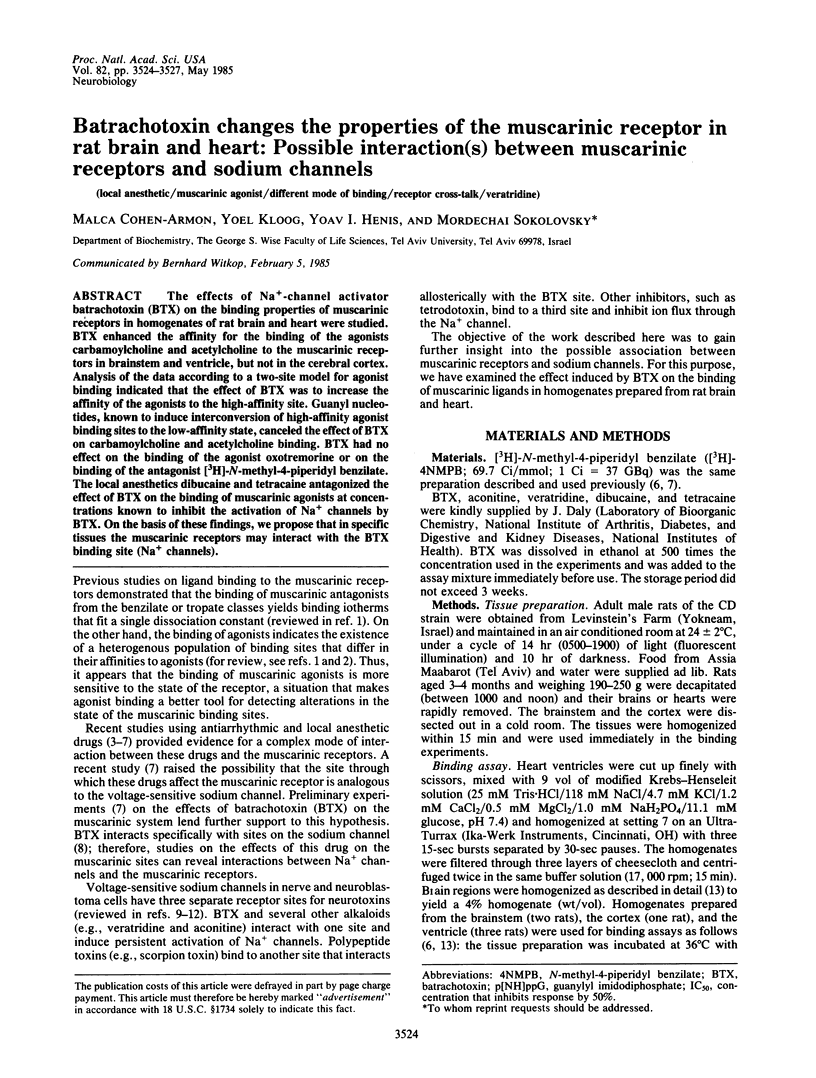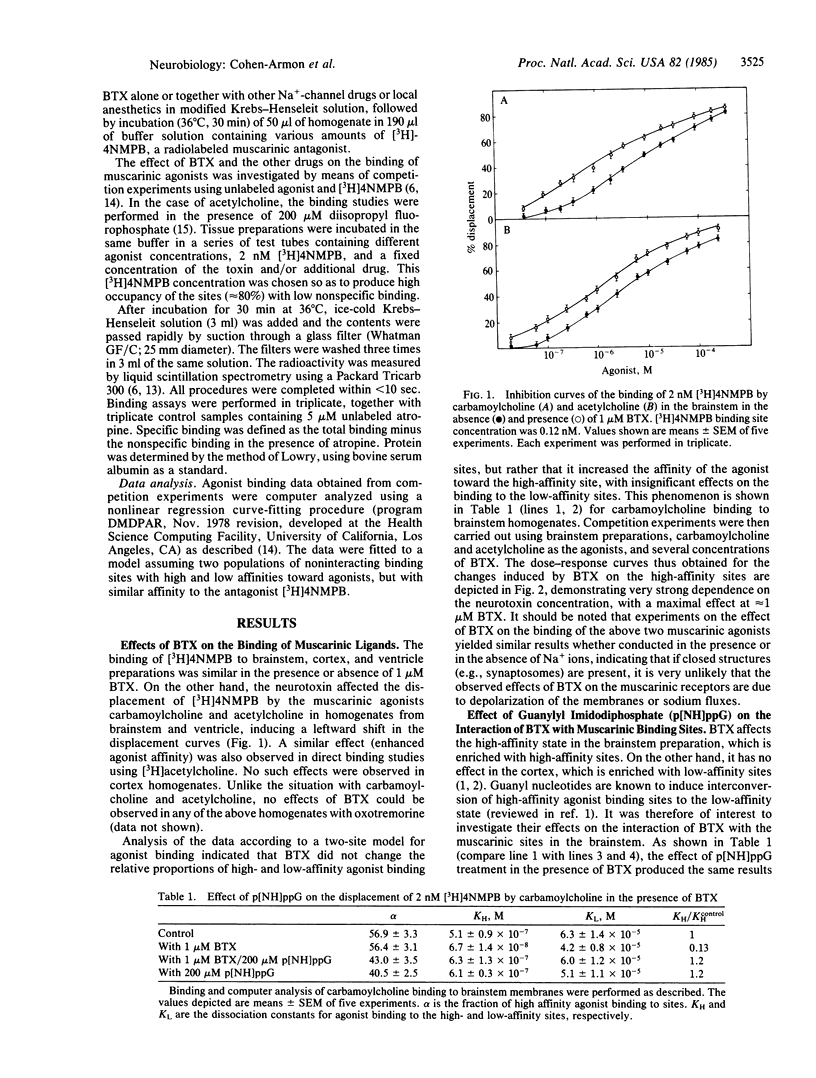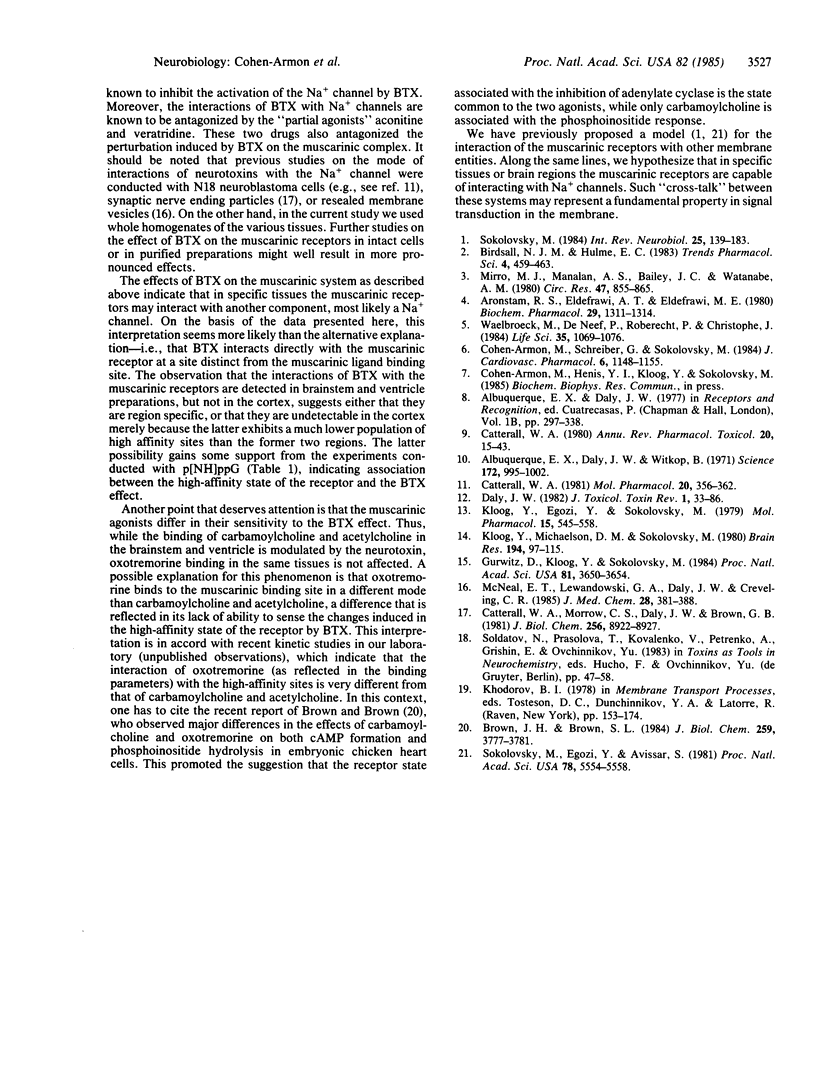Abstract
The effects of Na+-channel activator batrachotoxin (BTX) on the binding properties of muscarinic receptors in homogenates of rat brain and heart were studied. BTX enhanced the affinity for the binding of the agonists carbamoylcholine and acetylcholine to the muscarinic receptors in brainstem and ventricle, but not in the cerebral cortex. Analysis of the data according to a two-site model for agonist binding indicated that the effect of BTX was to increase the affinity of the agonists to the high-affinity site. Guanyl nucleotides, known to induce interconversion of high-affinity agonist binding sites to the low-affinity state, canceled the effect of BTX on carbamoylcholine and acetylcholine binding. BTX had no effect on the binding of the agonist oxotremorine or on the binding of the antagonist [3H]-N-methyl-4-piperidyl benzilate. The local anesthetics dibucaine and tetracaine antagonized the effect of BTX on the binding of muscarinic agonists at concentrations known to inhibit the activation of Na+ channels by BTX. On the basis of these findings, we propose that in specific tissues the muscarinic receptors may interact with the BTX binding site (Na+ channels).
Full text
PDF



Selected References
These references are in PubMed. This may not be the complete list of references from this article.
- Albuquerque E. X., Daly J. W., Witkop B. Batrachotoxin: chemistry and pharmacology. Science. 1971 Jun 4;172(3987):995–1002. doi: 10.1126/science.172.3987.995. [DOI] [PubMed] [Google Scholar]
- Aronstam R. S., Eldefrawi A. T., Eldefrawi M. E. Similarities in the binding sites of the muscarinic receptor and the ionic channel of the nicotinic receptor. Biochem Pharmacol. 1980 May 1;29(9):1311–1314. doi: 10.1016/0006-2952(80)90292-0. [DOI] [PubMed] [Google Scholar]
- Brown J. H., Brown S. L. Agonists differentiate muscarinic receptors that inhibit cyclic AMP formation from those that stimulate phosphoinositide metabolism. J Biol Chem. 1984 Mar 25;259(6):3777–3781. [PubMed] [Google Scholar]
- Catterall W. A. Inhibition of voltage-sensitive sodium channels in neuroblastoma cells by antiarrhythmic drugs. Mol Pharmacol. 1981 Sep;20(2):356–362. [PubMed] [Google Scholar]
- Catterall W. A., Morrow C. S., Daly J. W., Brown G. B. Binding of batrachotoxinin A 20-alpha-benzoate to a receptor site associated with sodium channels in synaptic nerve ending particles. J Biol Chem. 1981 Sep 10;256(17):8922–8927. [PubMed] [Google Scholar]
- Catterall W. A. Neurotoxins that act on voltage-sensitive sodium channels in excitable membranes. Annu Rev Pharmacol Toxicol. 1980;20:15–43. doi: 10.1146/annurev.pa.20.040180.000311. [DOI] [PubMed] [Google Scholar]
- Cohen-Armon M., Schreiber G., Sokolovsky M. Interaction of the antiarrhythmic drug amiodarone with the muscarinic receptor in rat heart and brain. J Cardiovasc Pharmacol. 1984 Nov-Dec;6(6):1148–1155. [PubMed] [Google Scholar]
- Gurwitz D., Kloog Y., Sokolovsky M. Recognition of the muscarinic receptor by its endogenous neurotransmitter: binding of [3H]acetylcholine and its modulation by transition metal ions and guanine nucleotides. Proc Natl Acad Sci U S A. 1984 Jun;81(12):3650–3654. doi: 10.1073/pnas.81.12.3650. [DOI] [PMC free article] [PubMed] [Google Scholar]
- Kloog Y., Egozi Y., Sokolovsky M. Characterization of muscarinic acetylcholine receptors from mouse brain: evidence for regional heterogeneity and isomerization. Mol Pharmacol. 1979 May;15(3):545–558. [PubMed] [Google Scholar]
- Kloog Y., Michaelson D. M., Sokolovsky M. Characterization of the presynaptic muscarinic receptor in synaptosomes of Torpedo electric organ by means of kinetic and equilibrium binding studies. Brain Res. 1980 Jul 21;194(1):97–115. doi: 10.1016/0006-8993(80)91321-9. [DOI] [PubMed] [Google Scholar]
- McNeal E. T., Lewandowski G. A., Daly J. W., Creveling C. R. [3H]Batrachotoxinin A 20 alpha-benzoate binding to voltage-sensitive sodium channels: a rapid and quantitative assay for local anesthetic activity in a variety of drugs. J Med Chem. 1985 Mar;28(3):381–388. doi: 10.1021/jm00381a019. [DOI] [PubMed] [Google Scholar]
- Mirro M. J., Manalan A. S., Bailey J. C., Watanabe A. M. Anticholinergic effects of disopyramide and quinidine on guinea pig myocardium. Mediation by direct muscarinic receptor blockade. Circ Res. 1980 Dec;47(6):855–865. doi: 10.1161/01.res.47.6.855. [DOI] [PubMed] [Google Scholar]
- Sokolovsky M., Egozi Y., Avissar S. Molecular regulation of receptors: interaction of beta-estradiol and progesterone with the muscarinic system. Proc Natl Acad Sci U S A. 1981 Sep;78(9):5554–5558. doi: 10.1073/pnas.78.9.5554. [DOI] [PMC free article] [PubMed] [Google Scholar]
- Sokolovsky M. Muscarinic receptors in the central nervous system. Int Rev Neurobiol. 1984;25:139–183. doi: 10.1016/s0074-7742(08)60679-0. [DOI] [PubMed] [Google Scholar]
- Waelbroeck M., De Neef P., Robberecht P., Christophe J. Inhibitory effects of quinidine on rat heart muscarinic receptors. Life Sci. 1984 Sep 3;35(10):1069–1076. doi: 10.1016/0024-3205(84)90071-7. [DOI] [PubMed] [Google Scholar]


